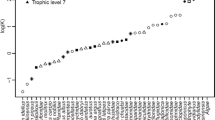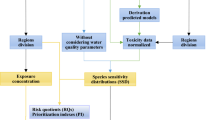Abstract
Tai Lake (Ch: Taihu), which is the largest lake in Jiangsu province, China, has been affected by human activities. As part of a concerted effort to improve water quality to protect the integrity of the Tai Lake ecosystem, a water quality criterion (WQC) was developed for copper (Cu) II. The acute WQC was based on 440 values for acute toxicity of Cu to 24 species from 6 phyla, 16 families, and 20 genera. In addition, 255 values for chronic toxicity of Cu to 10 species from 5 phyla, 8 families, and 9 genera were used to derive chronic WQC. Instead of using a traditional approach based species sensitivity distributions (SSD), a weighted species sensitivity distribution (WSSD) approach was used to calculate the cumulative probability based on endemic species to Tai Lake. Acute and chronic WQC developed by use of the WSSD were 5.3 and 3.7 μg Cu/L, respectively. While the WQC values were comparable to those of other countries, there were slight differences due to variability in species composition of different regions. The site-specific criteria indicated that the current standard set for surface water by the Chinese government might not be protective of aquatic organisms in Tai Lake.






Similar content being viewed by others
References
ANZE, Australian and New Zealand Environment Conservation Council and Agriculture and Resource Management Council of Australia and New Zealand (2000) Australia and New Zealand guidelines for fresh and marine water quality [R]. ANZECC and ARMCANZ, Australia
Baatrup E (1999) Structural and function effects of heavy metals on the nervous system, including sense organs of fish [J]. Comp Biochem Physiol 100C:253–257. doi:10.1016/0742-8413(91)90163-N
CCME, Canadian Council of Ministers of the Environment (1999) Protocol for the derivation of water quality guidelines for the protection of aquatic life [R]. Canadian Council of Ministers of the Environment, Winnipeg
Chapman PM, Wang F, Janssen C et al (1998) Ecotoxicology of metals in aquatic sediments: binding and release, bioavailability, risk assessment, and remediation [J]. Can J Fish Aquat Sci 55(10):2221–2243. doi:10.1139/f98-145
Chen JC, Lin CH (2001) Toxicity of copper sulfate for survival, growth, molting and feeding of juveniles of the tiger shrimp, Penaeusmonodon [J]. Aquaculture 192:55–65. doi:10.1016/S0044-8486(00)00442-7
Chen Y, Huang J, Xing LQ et al (2014) Effects of multi-generational exposures of D. magna to environmentally relevant concentrations of pentachlorophenol [J]. Environ Sci Pollut Res 21:234–243. doi:10.1007/s11356-013-1692-z
China EPA, China State Environmental Protection Administration (2002) GB3838-2002. Environmental quality standard for surface water (in Chinese). China Standards Press, Beijing
Di Toro DM, Allen HE, Bergman HL et al (2001) Biotic ligand model of the acute toxicity of metals. 1. Technical basis. Environ Toxicol Chem 20(10):2383–2396. doi:10.1897/1551-5028 (2001) 0202.0.CO;2
Duboudin C, Ciffroy P, Magaud H (2004) Effects of data manipulation and statistical methodson species sensitivity distributions [J]. Environ Toxicol Chem 23(2):489–499. doi:10.1897/03-159
EMEA (2004a) Committee for Medicinal Products for Veterinary Use (CVMP): Guideline on environmental impact assessment for veterinary medicinal products phase II. European Medicines Agency Veterinary Medicines and Inspections. EMEA, London, UK
EMEA (2004b) Committee for Medicinal Products for Human Use (CHMP): Guideline on the environmental risk assessment of medicinal products for human use. European Medicines Agency Pre-Authorization Evaluation of Medicines for Human Use. EMEA, London, UK
European Commission (2003) Technical guidance document in support of Commission Directive 93/67/EEC on risk assessment for new notified substances. Commission Regulation (EC) 1488/94 on risk assessment for existing substances and Directive 98/8/EC of the European Parliament and of the Council concerning the placing of biocidal products on the market. Ispra, Italy, p328
Feng CL, Wu FC, Zhao XL et al (2012) Water quality criteria research and progress [J]. Sci China Earth Sci 55(6):882–891. doi:10.1007/s11430-012-4384-5
Forbes VE, Calow P (2002) Species sensitivity distributions revisited: a critical appraisal [J]. Hum Ecol Risk Assess 8(3):473–492. doi:10.1080/10807030290879781
Forbes TL, Forbes VE (1993) A critique of the use of distribution based extrapolation models in ecotoxicology [J]. Funct Ecol 7:249–254
Giesy JP, Solomon KR, Coats JR et al (1999) Ecological risk assessment of Chlorpyrifos in North American aquatic environments [J]. Rev Environ Contam Toxicol 160:121–129. doi:10.1007/978-1-4612-1498-4_1
Hall LW, Scott MC, Killen WD (1998) Ecological risk assessment of copper and cadmium in surface waters of Chesapeake Bay watershed [J]. Environ Toxicol Chem 17:1172–1189
Jin X, Zha J, Xu Y et al (2012a) Toxicity of pentachlorophenol to native aquatic species in the Yangtze River [J]. Environ Sci Pollut Res 19:609–618. doi:10.1007/s11356-011-0594-1
Jin X, Zha J, Xu Y et al (2012b) Derivation of predicted no effect concentrations (PNEC) for 2,4,6-trichlorophenol based on Chinese resident species [J]. Chemosphere 86:17–23. doi:10.1016/j.chemosphere.2011.08.040
Jin X, Wang Z, Giesy JP et al (2014) Development of aquatic life criteria in China: viewpoint on the challenge [J]. Environ Sci Pollut Res 21:234–243. doi:10.1007/s11356-013-1667-0
Klimisch HJ, Andreae M, Tillmann U (1997) A systematic approach for evaluating the quality of experimental toxicological and ecotoxicological data [J]. Regul Toxicol Pharmacol 25(1):1–5. doi:10.1006/rtph.1996.1076
Kooijman SALM (1987) A safety factor for LC50 values allowing for differences in sensitivity among species [J]. Water Res 21:269–276. doi:10.1016/0043-1354(87)90205-3
Li US, Wu FC, Cui XY et al (2013) Derivation of an aquatic predicted no-effect concentration for endocrine disruptor effects of 17β-estradiol. Rev Environ Contam Toxicol 228:31–56
Liu YD, Wu FC, Mu Y-S et al (2014) Setting water quality criteria in China: approaches for developing species sensitivity distributions for metals and metalloids [J]. Rev Environ Contam Toxicol 230:35–58. doi:10.1007/978-3-319-04411-8_2
McCormick FH, Hill BH, Parrish LP et al (1994) Mining impacts on fish assemblages in the Eagle and Arkansas rivers, Colorado [J]. J Freshwater Ecol 9:175–179. doi:10.1080/02705060.1994.9664884
Meng W, Zhang Y, Zheng BH (2006) The quality criteria, standards of water environment and the water pollutant control strategy on watershed [J]. Res Environ Sci 19:1–3 (in Chinese)
Mu YS, Wu FC, Chen C et al (2014) Predicting criteria continuous concentrations of 34 metals or metalloids by use of quantitative ion character-activity relationships species sensitivity distributions (QICAReSSD) model [J]. Environ Pollut 188:50–55. doi:10.1016/j.envpol.2014.01.011
Posthuma L, Suter GW II, Traas TP (eds) (2002) Species-sensitivity distributions in ecotoxicology. Lewis, Boca Raton, FL, USA
Santore RC, Di Toro DM, Paquin PR et al (2001) Biotic ligand model of the acute toxicity of metals. 2. Application to acute copper toxicity in freshwater fish and Daphnia [J]. Environ Toxicol Chem 20(10):2397–2402. doi:10.1002/etc.5620201035
Schuler L, Hoang T, Rand G (2008) Aquatic risk assessment of copper in freshwater and saltwater ecosystems of South Florida. Ecotoxicology 17:642–659. doi:10.1007/s10646-008-0236-7
Stephan CE, Mount DI, Hansen DJ et al (1985) Guidelines for deriving numerical national water quality criteria for the protection of aquatic organisms and their uses. PB85-227049. National Technical Information Service, Springfield, VA, USA
Su Hailei (2011) The aquatic biota characteristics of Tai Lake and its relationship with the derivation of lake water quality criteria in China. Chinese Research Academy of Environmental Sciences, Thesis of Master Degree
Su HL, Wu F-C, Zhang R-Q et al (2014) Toxicity reference values for protecting aquatic birds in China from effects of polychlorinated biphenyls. Rev Environ Contam Toxicol 230:59–82
Suter GW, Cormier SM (2008) What is meant by risk-based environmental quality criteria [J]? Integr Environ Assess Manag 4:486–489. doi:10.1897/IEAM_2008-017.1
US EPA, United States Environment Protection Agency (2006) National recommended water quality criteria. Office of Water, Office of Science and Technology, Washington
Van Sprang PA, Verdonck FAM, Vanrolleghem PA et al (2004) Probabilistic environmental risk assessment of zinc in Dutch surface waters [J]. Environ Toxicol Chem 23:2993–300. doi:10.1897/03-444.1
Wheeler JR, Grist EPM, Leung KMY et al (2002) Species sensitivity distributions: data and model choice [J]. Mar Pollut Bull 45:192–202. doi:10.1016/S0025-326X(01)00327-7
Wu FC, Meng W, Zhao XL et al (2010) China embarking on development of its own national water quality criteria system [J]. Environ Sci Technol 44:7992–7993. doi:10.1021/es1029365
Wu FC, Feng CL, Cao YJ et al (2011) Aquatic life ambient freshwater quality criteria for copper in China [J]. Asian J Ecotoxicol 6(6):617–628 (in Chinese)
Wu FC, Mu YS, Hong C et al (2013) Predicting water quality criteria for protecting aquatic life from physico-chemical properties of metals [J]. Environ Sci Technol 47:446–453
Xing LQ, Liu HL, Giesy JP et al (2012) pH-dependent aquatic criteria for 2,4-dichlorophenol, 2,4,6-trichlorophenol and pentachlorophenol [J]. Sci Total Environ 441C:125–131. doi:10.1016/j.scitotenv.2012.09.060
Xing LQ, Liu HL, Zhang XW et al (2014) A comparison of statistical methods for deriving freshwater quality criteria for the protection of aquatic organisms [J]. Environ Sci Pollut Res 21:159–167. doi:10.1007/s11356-013-1462-y
Yin DQ, Jin HJ, Yu LW et al (2003) Deriving freshwater quality criteria for 2,4-dichlorophenol for protection of aquatic life in China [J]. Environ Pollut 122:217–222. doi:10.1016/S0269-7491(02)00292-0
Zhang R, Wu FC, Li HX et al (2013) Toxicity reference values and tissue residue criteria for protection of avian wildlife exposed to methylmercury in China. Rev Environ Contam Toxicol 223:53–80
Zhou QX, Luo Y, Zhu LY (2007) Scientific research on environmental benchmark values and revision of national environmental standards in China [J]. J Agron-Environ Sci 26(1):1–5 (in Chinese)
Acknowledgments
This work was jointly funded by the National Natural Science Foundation of China (No. 21377053 and 20977047), Major National Science and Technology Projects (No. 2012ZX07506-001 and 2012ZX07501-003-02). Prof. Giesy was supported by the program of 2012 “High Level Foreign Experts” (No. GDW20123200120) funded by the State Administration of Foreign Experts Affairs, the People’s Republic of China to Nanjing University, and the Einstein Professor Program of the Chinese Academy of Sciences. He was also supported by the Canada Research Chair program, a Visiting Distinguished Professorship in the Department of Biology and Chemistry and State Key Laboratory in Marine Pollution, City University of Hong Kong. Great thanks to David Saunders, a vanier scholar in ecotoxicology studying in Toxicology Centre, University of Saskatchewan, for his time in polishing our manuscript.
Author information
Authors and Affiliations
Corresponding author
Additional information
Responsible editor: Thomas Braunbeck
Electronic supplementary material
Below is the link to the electronic supplementary material.
ESM 1
(DOCX 127 kb)
Rights and permissions
About this article
Cite this article
Shi, R., Yang, C., Su, R. et al. Weighted species sensitivity distribution method to derive site-specific quality criteria for copper in Tai Lake, China. Environ Sci Pollut Res 21, 12968–12978 (2014). https://doi.org/10.1007/s11356-014-3156-5
Received:
Accepted:
Published:
Issue Date:
DOI: https://doi.org/10.1007/s11356-014-3156-5




